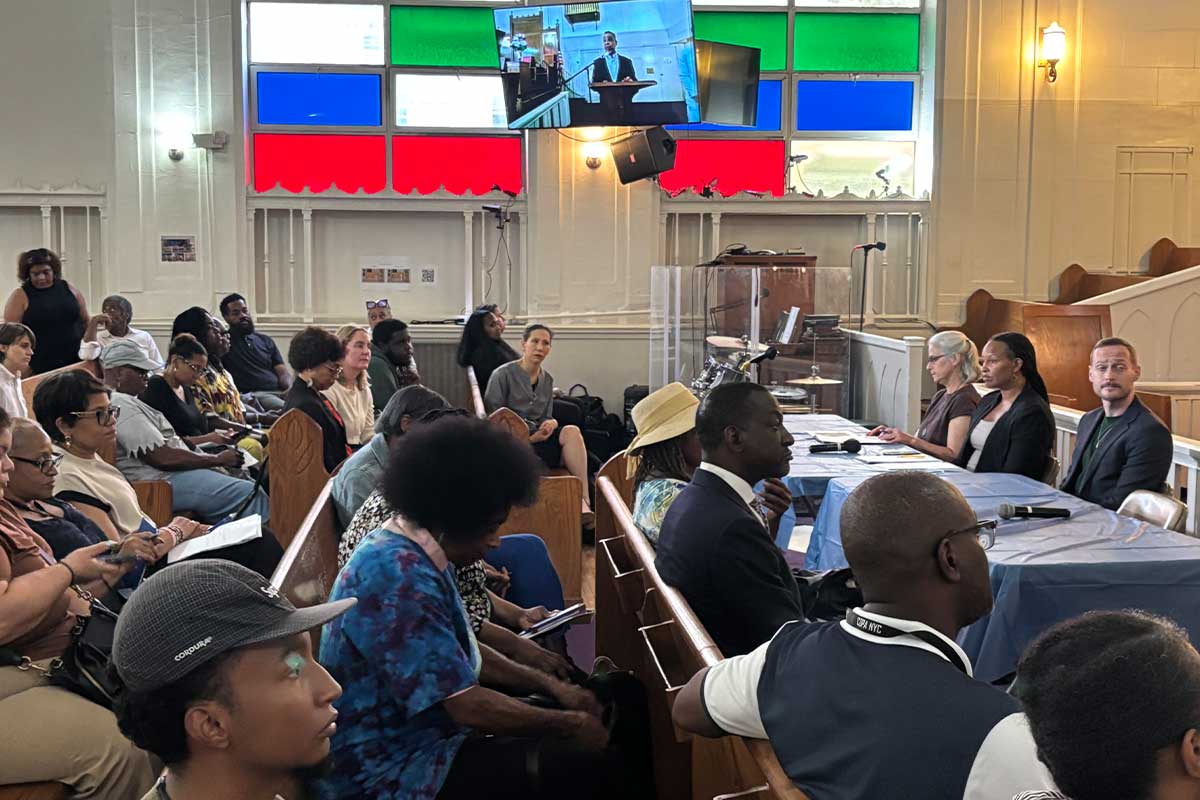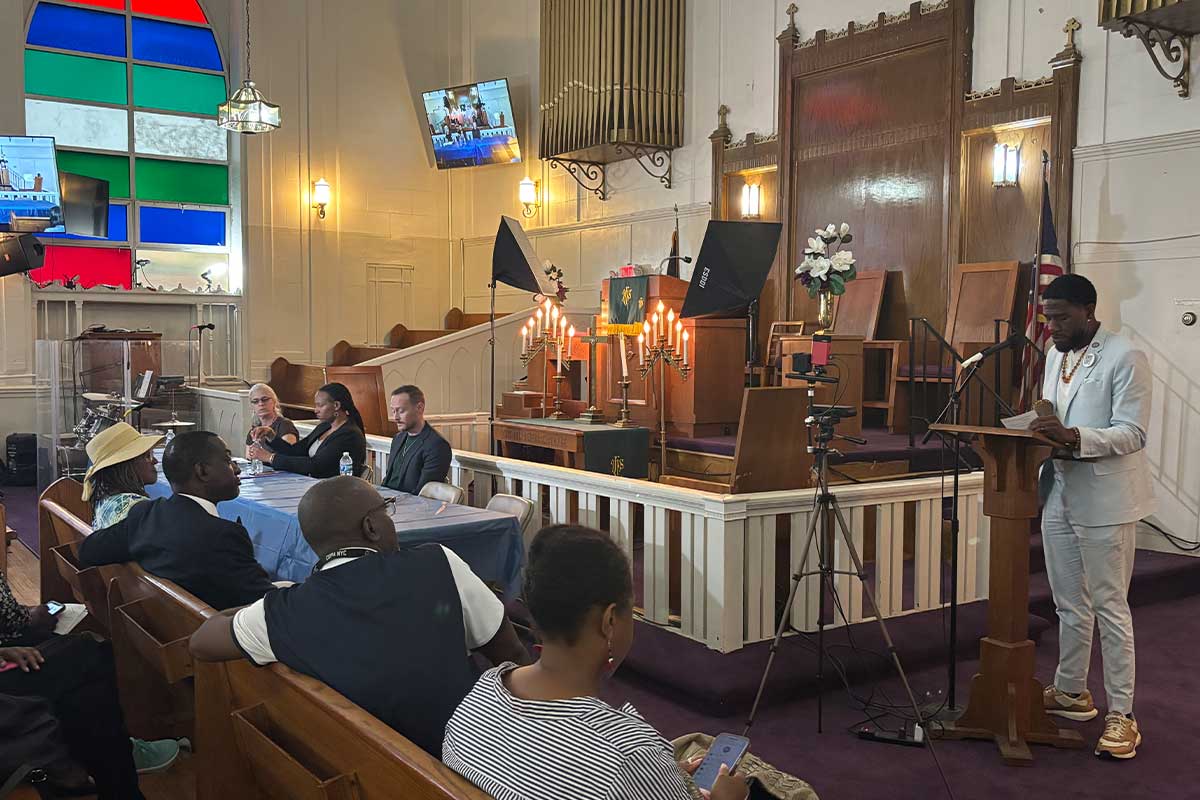On August 14, 2025, the Office of the Public Advocate, NYC Department of Health and Mental Hygiene Acting Commissioner Morse, MD, MPH; NYC Health + Hospitals; Congressman Adriano Espaillat; New York State Senator Cordell Cleare; Assemblymember Jordan J.G. Wright; Assemblymember Al Taylor; Council Member Yusef Salaam; Manhattan Borough President Mark Levine; and medical experts hosted a Town Hall at Mt. Zion AME Church to address the latest Legionnaires’ outbreak in Harlem.
The event aimed to help answer constituents’ questions, both in person and online, and you can watch it in full on Facebook. We’ll recap the main takeaways below.
What Is Legionnaires’ Disease?
Legionnaires’ Disease is a type of pneumonia caused by the Legionella bacteria, which grows in warm water. Symptoms might develop anywhere between two days and two weeks of exposure. It’s rarely seen in children and, so far, never seen in pets.
How do I Know if I Have Legionnaires’ Disease?
Most individuals that are exposed to the Legionella bacteria do not develop the disease. For those that become symptomatic, it can feel a lot like the beginning of a common cold or the flu. If you have been near the affected zip codes and develop symptoms like:
- Fever
- Cough
- Chills
- Body aches
Please seek immediate medical attention, especially if you’re over 50 years old, smoke, or have a chronic health condition. Check regularly on your family and neighbors, as such common symptoms can easily be ignored by those unaware of the outbreak. Legionnaires’ disease can be fatal and an early diagnosis is crucial for a better outcome.
How Can you Become Infected with Legionnaires’ Disease?
Legionnaires’ disease does not spread from person to person. You contract the disease by breathing in contaminated water vapor. Legionella bacteria does not develop only in cooling towers, but such towers do provide optimum conditions for contamination when not maintained properly. There’s strong evidence that the source of the most recent outbreak were contaminated cooling towers. Drinking water, cooking, bathing, and using air conditioning is still safe.
According to experts, there’s currently no evidence that wearing a mask is effective against the Legionella bacteria.

Where Was the Outbreak?
Twelve cooling towers in Central Harlem have tested culture positive on 10 buildings for live Legionella bacteria as of this writing. While the contamination seems to have been remediated, experts ask residents of the following zip codes to remain especially vigilant about any signs of Legionnaires’ Disease symptoms:
- 10027
- 10030
- 10035
- 10037
- 10039
A Crisis with Racial Overtones
Representative Adriano Espaillat opens his remarks reminding us that “This happens far too often in this neighborhood.” He referred to previous deadly outbreaks, which always seem to take place between the South Bronx and Harlem. He continues: “Why is it happening here?”
While the disease itself does not discriminate who it infects and where it develops, lack of systematic preventative measures make it far more common in poor, Black and brown neighborhoods; places where residents already struggle with a high incidence of respiratory illness due to poor air quality and difficulties in accessing healthcare. Harlem has one of the highest concentrations of Medicaid recipients in the city and state, and under the “One Big Beautiful Bill Act,” which President Donald Trump signed last month, even that resource will become more scarce. In the words of Council Member Yusef Salaam:
“This is not just a public health issue. This is about environmental justice. This is about whether Black and brown communities get the same attention, get the same urgency, get the same investment and safety as every other neighborhood in New York City.”
While Commissioner Morse acknowledges structural racism as a factor, she also reminds us that the combination of high population density and a large number of very tall buildings present in Upper Manhattan and South Bronx play a significant role in the development of the cluster.
Prevention and Oversight
Testing results for cooling towers in NYC are publicly available, but there is a six-month lag in posting inspection data. All cooling towers must be registered with the city and building owners must conduct Legionella sampling and compliance inspections every 90 days. Though the Health Department is in charge of enforcing these rules, staffing shortages brought such inspections to a near-record low. That’s unacceptable and may have contributed to the most recent outbreak. The law also does not specify how often the city must carry out its own inspections.
“People don’t connect the lack of inspectors to actual deaths that are occurring, and this is one instance where that might be the case.” – Public Advocate Jumaane D. Williams
It’s important to emphasize, though, that inspections do not completely eliminate the risk of a new Legionella cluster.
New York City has very strict rules for cleaning and maintaining cooling towers, but that is not helpful if building owners do not follow them. The current level of fines of $1,000 for a first offense and $2,000 for each additional offense are not enough to force compliance, says Jory Lange, a lawyer who specializes in Legionnaires’ cases.
Our office recommends increasing staffing capacity to conduct more frequent inspections, increased fines for violations, and expanded investment in public health.
We’d like to thank all of those who attended the town hall either in person or virtually. This shows the community is engaged, aware of the issues, and actively demanding solutions. If you could not attend, there are other ways to continually support your community and hold those in charge accountable.
You can learn more about your Community Board and how to attend their meetings, contact your Council Members, or contact the Office of the Public Advocate. Concerns can also be addressed by calling 311 or emailing communityaffairs@health.nyc.gov.
As of August 22, 2025, a 6th person died linked to the Legionnaires’ Disease outbreak.
Photos: Curtis Young for the Office of the Public Advocate
Don't miss the latest from the Office of the Public Advocate.Subscribe to the Advocate Bulletin newsletter.
